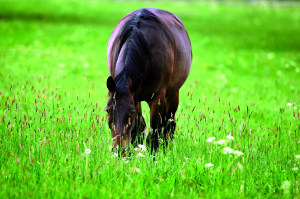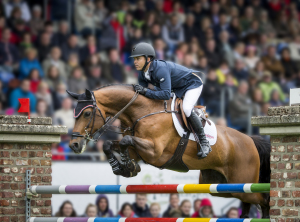Best Cavalor Feed for 4 Yr Old
Matching the Right Feed to Your Horse's Need
Understanding the importance of feeding your horse according to its nutritional requirement.
By: Caroline Loos
Similar to humans and many other species maintaining a healthy body condition (BC) in horses can only be obtained by ensuring their feed is appropriately matched with their nutritional requirements. Unfortunately, estimation of a horse's needs is often still done through guesswork rather than looking for proper guidelines (e.g. FRASC® ration calculator software) or advice often resulting in under- or overfeeding of the horse. In particular the latter seems to be a frequent issue reflected by the high prevalence of obesity in horses, which can lead to detrimental complications such as insulin resistance and laminitis. Even though feed companies are required to put the necessary information regarding their product on the feed tag, many horse owners do not read this information or do not properly understand what it means. Therefore this review will highlight the important differences in nutritional requirements for various types of horses.
To prevent health issues and ensure your horse is properly fed, the most important step is to be aware of specific nutritional requirements for a particular "physiological state" or "class" of horse. This will allow you to determine how much feed is needed to provide the necessary nutrients. The NRC (National Research Council) lists nutritional requirements for various classes of horses based on their age, weight, physiological status and workload. The first element to consider when evaluating a horse ration is the amount of forage that is fed, which should always be the foundation upon which the diet is based, regardless of the class of horse. A minimum of 1% but preferably 1.5 to 2% of body weight in daily forage is advised to maintain healthy gut function. Any additional requirements can then be met with additional concentrate or ration balancers.
Nutritional requirements are typically categorized by nutrient class and generally we start by looking to meet the digestible ENERGY (DE) needs of the horse. Energy can be provided through carbohydrates (e.g. starch, sugars and fiber), fats and to a lesser extend also by protein. A more thorough review on the energy component of feeds can be found in other articles on this website. Other important nutrients to look at on a feed tag are crude PROTEIN (CP), CALCIUM (Ca), PHOSPORUS (P) and the ratio of Ca/P. Additionally it is important to know the amount of feed a horse can consume in a day, which is generally estimated to be about 2-2.5 % of its body weight (with exceptions). Realizing edible portion sizes are limited becomes important in particular for those horses with extremely high nutritional demands. In these occasions it is necessary to provide high quality feeds to make sure all needed nutrients are consumed.
Feeding the "Maintenance" Horse
A horse at maintenance is considered one that is
Feeding the Broodmare
Generally speaking a broodmare can be in 4 different physiological stages: getting pregnant, pregnant, lactating and post weaning. Often these stages may overlap, for example a mare with a foal on her side can be bred again and be in early stages of pregnancy while lactating. Therefore broodmares require high levels of good quality nutrients for their own maintenance as well as support fetal growth and milk production. Nutritional demands rise toward the late stages of pregnancy and peak during early lactation. For example, in the first 2 months of lactation, DE requirements are similar to those of a thoroughbred race horse or elite 3-day eventers in heavy training/competition. In addition to energy, the demand forhigh quality protein, Ca and P during this time is higher than in any other class of horses, which is expected as all of these nutrients are essential for the production of milk. Two important concepts to be aware of in feeding broodmares is 1) that they are highly capable of using their own body stores to ensure adequate nutrient supply to the fetus and nursing foal if diet is insufficient; and 2) that body condition has a considerable impact on reproductive efficiency. To avoid health issues and reproductive problems due to over- or underfeeding it is important to provide the mare with adequate nutritional support during the various stages of her breeding cycle and monitor BC closely. Due to high nutritional demands, large portions of concentrate will need to be fed which should be introduced gradually and always be accompanied by a highly digestible fiber source (e.g. early mature hay or vegetative pasture) to prevent digestive upset. As it is known that broodmares sometimes go off their feed in late gestation or simply cannot eat the amount necessary to meet requirements in a day it is advised thatthe nutrients in the feed are of premiumquality. (Cavalor® Probreed) (Cavalor® Fifty-Fifty) .
Next to meeting requirements during the most demanding periods of the breeding cycle, it is equally important, and oftentimes overlooked, to provide adequate feed after weaning. Research showed this is a crucial period of "replenishing" the body stores which the mare has utilized to support milk production. In particular attention should be given to adequate Ca and P for bone mineral repletion. Post weaning feed management is important for getting the mare ready for her next gestation cycle.
Feeding the Growing Horse
Growth and accretion of tissues, such as muscle, body fat and bone, requires a large supply of nutrients and consequently research has shown that diet can have tremendous effects on the development of young, growing horses. From the first sips of highly nutritious colostrum to foal starters and eventually different types of concentrate consumed by the growing horse, thequality of the feed and proper dietary management is of utmost importance to prevent developmental abnormalities or diseases. In particular the first year is critical in the skeletal development of the young horse and mistakes in nutrition and management can have a lifelong impact. The main goal is therefore to provide all essential nutrients in a proper ratio that will ensure a moderate, even growth rate, closely monitored by tracking weight gain and BC.
Meeting energy requirement in the growing animal is essential and oversupply of other nutrients can never overcome a limited energy supply. Energy can be provided through lactose and lipid in the mare's milk or starch, fat and fiber in concentrates and forages. After meeting requirements for DE, attention should be given to the amino acid profile (i.e. protein quality) of the protein in the feed. Certainessential amino acids such as lysine have a large impact on growth and should be provided adequately (~4.3% of dietary protein). Additionally, the higher the protein quality the less total protein will be needed. Other nutrients such as vitamins and minerals, in particular the Ca:P ratio, should be supplied in adequate amounts following proper rate of growth. Incorporating a lot of fresh forage in the diet will help to meet the demands of many of those nutrients.
During the first months of life, the mare will provide most nutrients through her milk, however soon the foal will start nibbling on forage and concentrate from the mare. Creep feeding (e.g. Cavalor® Start & go soft ) may be an option to provide additional nutritional support for the foal, however, many commercial broodmare feeds (e.g. Cavalor® Probreed)(Cavalor® Fifty-Fifty )( can safely be consumed by the foal as it transitions to a more solid diet. If the foal is eating along with the dam it is important to account for this when measuring feed amounts to ensure all the mare's requirements are still met.
The weaning process is a stressful period in a young horses' life from both an emotional and dietary standpoint since the nutrients provided by the milk will suddenly be lost. Inadequate feeding management often results in a "post weaning growth slump" which can be prevented by reducing stress during weaning and proper dietary preparation of the foal.
Adequate nutritional support throughout the first 24 months of a growing horses' life is essential. A combination of high quality forage supplemented with premium feeds (e.g. Cavalor® Probreed, Cavalor® Juniorix) will contribute to proper development and better health in later stages of life.
Feeding the Performance Horse
The main goal of feeding an athlete is to meet dietary requirements formaintenance and supply the nutrients needed to performexercise. However,additional factors need to be taken into consideration when optimizing the ration of a performance horse such as sport discipline, age, breed and environment. For example a young horse may need extra feed in order to also support growth or the energy expenditure during transportation needs to be taken into account when feeding before or after a trip. As with all other horse classes, close monitoring of body weight and BC is crucial!
The overall nutritional requirements depend largely on the workload (i.e. duration, intensity and frequency) of the horse, which is commonly overestimated by many horse owners. The NRC determined 4 levels of work: light (~1-3h/wk walk & trot), moderate (~3-5h/wk trot canter, easy skills), heavy (~4-5h/wk trot, canter, gallop, hard skills) and very heavy (advanced race training, elite 3-day eventer, all day endurance rides,…). To meet nutritional demands, in particular for those in heavy training, high levels of energy are necessary. This can only be provided by large amounts of concentrate. Consequently, frequent problems in equine athletes aregastro-intestinal disturbances due to digestive upset when consuming large portions of grain. To meet nutritional requirements while maintaining a healthy gut function it is advised to feed a highly palatable and digestible concentrate, in combination with a fiber source, such as good pasture or early mature hay. A high quality forage will not only contribute to a healthy gut but also provide a good portion of daily nutrients which reduces the amount of daily concentrate needed.
When selecting a horse feed for your athlete it is important to consider what "kind of nutrients" your horse needs most (i.e. slow release energy, explosive energy, muscle building,…) and carefully read the feed tags and additional information provided by the feed company. Next to energy other nutrients that are essential to support the equine athlete are high quality protein (i.e. containing proper ratios of amino acids necessary for muscle build up), and minerals such as electrolytes, which are easily lost during sweating. Furthermore vitamins play an important role in different metabolic pathways and should be present in sufficient amounts in the diet.
The Perfect Balance
In conclusion, when balancing your horses' ration it is imperative to be knowledgeable of the nutritional demands for your class of horse. Furthermore it is important to realize that many different factors may affect these requirements such as breed, gender, ambient temperature, seasonality, environment and individual characteristics of the horse. Therefore scientific literature can be used as a starting point but close monitoring of your horses' body condition and general health is advised to ensure any adjustments can be made when necessary. Additional support can be obtained through either contacting a professional nutritionist or informational platforms offered by the feed company, such as Cavalor University, or online ration calculator programs such asFRASC® offered by Cavalor®. Finally, developing a good relationship with your horse will allow you to notice problems early on and make dietary changes quickly when needed.
About the Author
Share This Story, Choose Your Platform!
Source: http://cavaloracademy.com/matching-the-right-feed-to-your-horses-need/


0 Response to "Best Cavalor Feed for 4 Yr Old"
Post a Comment